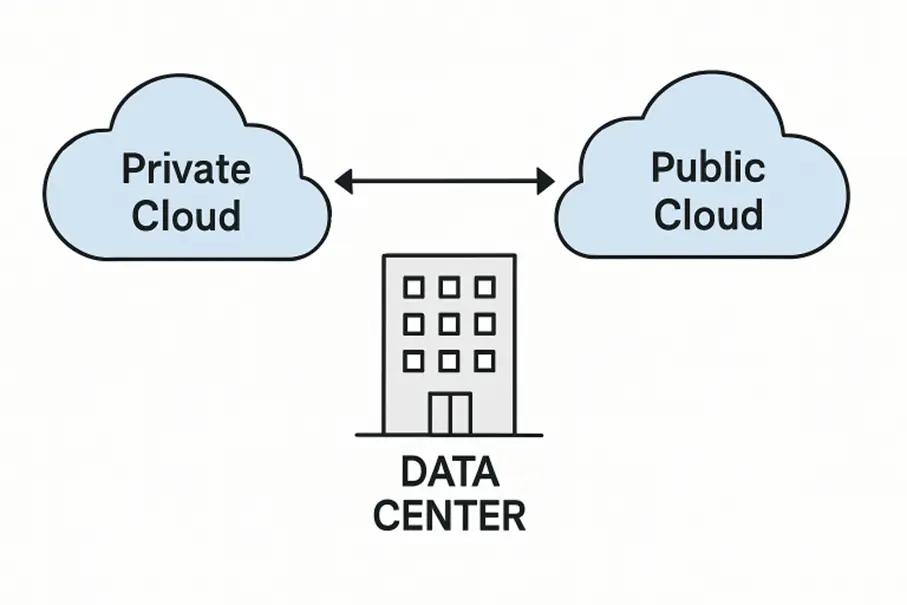Hybrid Cloud Solutions for Modern Businesses
Adopting a hybrid cloud model enables businesses to balance scalability, security, and control in today’s fast-changing digital environment. By uniting public and private cloud infrastructures, organizations can optimize workloads, reduce costs, and ensure that sensitive data remains protected while leveraging the flexibility of on-demand resources. This approach supports critical enterprise applications, enhances compliance, and delivers the agility to adapt quickly to evolving customer demands and market conditions. With added benefits such as AI-driven automation, analytics, and edge computing, hybrid environments empower companies to innovate faster while maintaining governance and resilience. Ultimately, this strategy allows organizations to modernize IT operations, improve performance, and create a strong foundation for sustainable growth and long-term competitiveness.
Introduction
Organizations increasingly turn to hybrid cloud strategies to address evolving IT requirements in today’s dynamic digital era. These solutions skillfully blend private and public cloud environments, enabling companies to reap flexibility and security benefits. For companies integrating robust enterprise applications, hybrid cloud architectures offer a unique advantage, allowing seamless migration, management, and scaling of critical business workloads.
Through a hybrid approach, businesses can maintain control over sensitive operations while taking full advantage of the scalability and cost-effectiveness of public cloud solutions. This dual setup accelerates digital transformation, optimizes IT expenditures, and enhances operational agility. Forward-looking organizations realize that a well-strategized hybrid cloud deployment is essential for remaining competitive in today’s fast-paced marketplace.
Understanding Hybrid Cloud
A hybrid cloud environment seamlessly integrates on-premises private infrastructure with third-party public cloud resources. This setup allows organizations to move data and applications between clouds as needs and costs fluctuate while maintaining key control points and ensuring security for regulated or mission-critical workloads. The hybrid model is particularly well-suited to businesses that require the versatility of the cloud without relinquishing control over core data or processes, such as financial services and healthcare enterprises.
Key Benefits of Hybrid Cloud
- Flexibility and Scalability: Hybrid cloud infrastructure enables rapid scaling of IT resources during sudden surges in demand, ensuring service continuity and performance. Businesses no longer need to overinvest in redundant on-premises resources, achieving maximum ROI.
- Cost Efficiency: By offloading less sensitive tasks to public clouds, companies can reduce capital spend on local data centers and utilize pay-as-you-go models offered by cloud vendors. This aligns expenses with actual usage while supporting innovation.
- Enhanced Security: Organizations can keep confidential information and regulatory workloads in private clouds, retaining oversight and control. Meanwhile, the public cloud handles high-volume, low-sensitivity tasks, balancing risk and productivity.
Implementing Hybrid Cloud Strategies
Effective execution of a hybrid cloud strategy requires careful alignment with business objectives. Begin by assessing each workload, identifying which are best suited for the private cloud due to compliance or security concerns, and which can utilize the scalability of the public cloud. Collaboration with trusted technology providers and adopting interoperable solutions to prevent vendor lock-in is essential.
- Assess Business Needs: Evaluate applications for latency, security, and compliance needs. Mission-critical workloads may always remain on-premises, while non-sensitive datasets can migrate to the public cloud for elasticity.
- Select Appropriate Providers: Choose vendors with a proven track record in hybrid deployments and who offer powerful management tools and secure, open integrations.
- Develop a Migration Plan: Build a comprehensive roadmap for phased migration, including thorough testing, data synchronization, and training to ensure minimal disruption.
- Implement Management Tools: Use platforms that allow unified visibility over private and public cloud estates, streamline administration, and surface actionable insights.
Challenges and Solutions
Hybrid cloud architectures introduce new complexities, yet these can be addressed by strong governance and automation:
- Complexity: Operating multiple cloud environments can overwhelm IT teams. Solution: Invest in automation and orchestration tools such as Kubernetes, which standardize workflows and automate cloud deployment.
- Security Risks: Transferring data between clouds increases risk. Solution: To protect sensitive information, adopt end-to-end encryption, rigorous access controls, and continuous monitoring.
- Compliance Issues: Navigating regulatory requirements across jurisdictions can be daunting. Solution: Map out data residency and sovereignty requirements, regularly audit cloud policies, and ensure complete transparency from cloud partners.
Case Studies of Successful Adoption
- Retail Industry: Leading retailers have transformed their operations by leveraging hybrid cloud to unify e-commerce, brick-and-mortar, and mobile experiences. Data-driven insights from cloud analytics tools tailor recommendations, personalize marketing campaigns, and fine-tune inventory management. This results in smoother customer journeys and greater loyalty, as seen in case studies from major brands featured in IBM Newsroom.
- Education Sector: Universities and schools are deploying scalable hybrid e-learning platforms, ensuring reliability even during exam surges with thousands of concurrent users. Hybrid environments ensure sensitive student records remain secure on-site, while public cloud enhances performance for global education delivery.
Future Trends in Hybrid Cloud
- Integration of Edge Computing and 5G: Next-generation hybrid architectures will harness edge devices and 5G networks, enabling real-time processing closer to users. This impacts use cases requiring fast decision-making, like autonomous vehicles and Internet of Things (IoT) applications.
- Emphasis on Sustainability: Cloud providers focus on sustainability, integrating renewable energy sources, and optimizing resource allocation. Organizations prioritize energy-efficient infrastructure to reduce environmental footprints and meet corporate social responsibility goals.
Conclusion
The hybrid cloud model is transforming the way modern enterprises design, deploy, and manage IT services, offering a dynamic balance of scalability, security, and control. By seamlessly integrating the strengths of public clouds with the dedicated reliability of private environments, organizations can optimize workloads, reduce unnecessary costs, and meet compliance requirements more effectively. This flexibility enables businesses to scale resources on demand, safeguard sensitive data, and maximize efficiency across diverse operations. Furthermore, the hybrid approach supports innovation by allowing advanced capabilities such as AI-driven automation, real-time analytics, and edge computing. As digital transformation accelerates, a carefully planned hybrid cloud strategy becomes essential for ensuring business resilience, enhancing performance, and adapting to the ever-changing technology landscape while maintaining a foundation for sustainable, long-term growth.
Also Read-Air Lubricator Essentials: What B2B Buyers Should Know Before Installing

